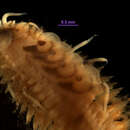Comprehensive Description
provided by Smithsonian Contributions to Zoology
Malmgreniella baschi
MATERIAL EXAMINED.—EASTERN PACIFIC OCEAN: California: Santa Catalina Island, Big Fisherman Cove, 33°27′N, 118°29′W, sand, 8–30 m, associated with ophiuroid Ophiopsila californica A.H. Clark, L.W. Basch, collector: no 5C, 20 Jul 1982, paratype (USNM 133582); no 6 and 7, 28 Jul 1982, 2 paratypes (USNM 133583; no 8, 24 Nov 1982, paratype (LACM); no 10, 9 Apr 1983, 2 paratypes (USNM 133584); no 11, 10 Apr 1983, 2 paratypes (USNM 133585); no 12, 16 Apr 1983, holotype (USNM 133581).
DESCRIPTION.—Holotype, male with sperm, 14 mm long, 4.5 mm wide including setae, with 38 segments and 15 pairs of elytra; figured paratype (USNM 133582), incomplete male with sperm. 9+ mm long, 5 mm wide, with 28+ segments; paratype (LACM), female with eggs, 9 mm long, 3.5 mm wide, with 37 segments.
Black pigmented bands on posterior 4 segments of dorsum and posterior 8 segments of ventrum. Elytra 15 pairs, oval to subreniform, delicate, opaque, with micropapillae on posterior and lateral borders and small group of microtubercles on anterior part of few elytra; some light to dark mottled pigmentation forming spots over place of attachment to elytrophores and larger C-shape areas more posteriorly (Figure 47C,D). Bilobed prostomium with anterior lobes subtriangular, without distinct peaks, with mottled pigmentation; 2 pairs of eyes, anterior pair larger, anteroventral, anterior to widest part of prostomium and not visible dorsally, smaller posterior pair near posterior border; ceratophore of median antenna in anterior notch, with style about twice as long as prostomium, with slender tip; lateral antennae with ceratophores inserted ventrally, with short subulate styles; palps long, tapered; tentaculophores without setae, with brown pigment spots; dorsal and ventral tentacular cirri similar to median antenna (Figure 47A,B). Second segment with biramous parapodia and long ventral buccal cirri similar to tentacular cirri.
Biramous parapodia with notopodia shorter than neuropodia, rounded, with projecting acicular lobe on lower side; neuropodium with presetal acicular lobe subconical, with digitiform supraacicular process; postsetal lobe shorter, rounded (Figure 47E,F). Notosetae numerous, forming radiating bundle, short to long, about as stout as neurosetae, tapering to short bare tips, with faint close-set spinose rows (Figure 47G). Neurosetae moderate in number, forming fan-shape bundle; supraacicular neurosetae with long spinose region with prominent spines, upper few tapering to pointed tips, some lower ones with slight indication of secondary tooth (Figure 47H); subacicular neurosetae with shorter spinose region, less prominent spines, and slightly hooked, bare tips (Figure 47I). Dorsal cirri with prominent cylindrical cirrophore, ciliated on upper side, with black pigment on lower side; style long, flattened, with scattered micropapillae, and slender tip extending beyond tips of neurosetae; dorsal tubercles nodular; ventral cirri short, tapered, with micropapillae (Figure 47F). Pygidium with dorsal anus medial to posterior parapodia, with pair of long anal cirri.
BIOLOGY.—The specimens were collected at night by L.W. Basch from the discs of the very large and brilliantly bioluminescent ophiuroid Ophiopsila californica A.H. Clark, in 8–30 meters off Santa Catalina Island. According to the collector, the ophiuroids dwell in sand and in tubes of Chaetopterus variopedatus (Renier).
ETYMOLOGY.—The species is named for Lawrence V. Basch, the collector and donor of the specimens.
DISTRIBUTION.—East Pacific Ocean, off southern California, in 8–30 meters.
- bibliographic citation
- Pettibone, Marian H. 1993. "Scaled polychaetes (Polynoidae) associated with ophiuroids and other invertebrates and review of species referred to Malmgrenia McIntosh and replaced by Malmgreniella Hartman, with descriptions of new taxa." Smithsonian Contributions to Zoology. 1-92. https://doi.org/10.5479/si.00810282.538

